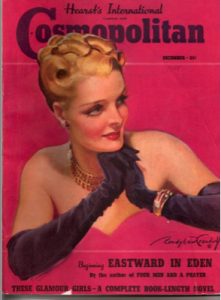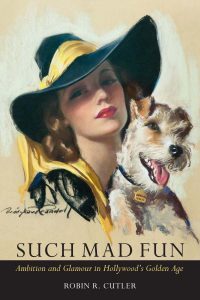Cover Girls — Behind the Mask
 “44 Sex Tips From Around the World — Prepare for Global Warming” . . . “Unexpected Sex Advice—How to Turn Yourself On” shouts the September 2016 cover of Cosmopolitan, one of America’s top twenty magazines by circulation. (Digital circulation 14.6 million unique visitors and growing.) The magazine’s mission: to empower young women “to own who they are and be who they want to be.” The seductive blonde in the glittering, revealing gold dress on the cover (Gwen Stefani) leaves no doubt as to what she has in mind. In fact, in some grocery stores, the Cosmo cover is hidden by an opaque sleeve.
“44 Sex Tips From Around the World — Prepare for Global Warming” . . . “Unexpected Sex Advice—How to Turn Yourself On” shouts the September 2016 cover of Cosmopolitan, one of America’s top twenty magazines by circulation. (Digital circulation 14.6 million unique visitors and growing.) The magazine’s mission: to empower young women “to own who they are and be who they want to be.” The seductive blonde in the glittering, revealing gold dress on the cover (Gwen Stefani) leaves no doubt as to what she has in mind. In fact, in some grocery stores, the Cosmo cover is hidden by an opaque sleeve.
But let’s look back to December 1938 when another stunning blonde graced the cover of Hearst’s International- Cosmopolitan Magazine.
Her diamond and ruby jewelry complements the top of her rose strapless evening dress; elbow length dark violet gloves protect the elegant hands that are folded under her chin. Surely she expects her dream prince to arrive at any moment in a tuxedo with an orchid corsage to take her dancing. This “Cosmopolitan Lady” (actress Miriam Jordan) is a pastel illustration by Bradshaw Crandell, a Society of Illustrators Hall of Famer whose work still hangs at the 21 Club in New York City.
 Once they opened the magazine, readers could choose any one of several articles. They might learn what it’s like to vote for the first time, about job opportunities in Alaska or the Philippines; or they could explore the reasons why boys find playing G-man (federal agent) more appealing than playing soldier. They might turn to Elsa Maxwell’s insights on heiress Barbara Hutton or to the most recent encouraging research from Stanford University about marital happiness.
Once they opened the magazine, readers could choose any one of several articles. They might learn what it’s like to vote for the first time, about job opportunities in Alaska or the Philippines; or they could explore the reasons why boys find playing G-man (federal agent) more appealing than playing soldier. They might turn to Elsa Maxwell’s insights on heiress Barbara Hutton or to the most recent encouraging research from Stanford University about marital happiness.
But if they hoped to escape from their worries at work or at home through mysteries or romance, they dove into the magazine’s eight short stories, three serials, or the “book-length novel” by Jane Hall who, the editor noted, is “hard at work on the film version of ‘These Glamour Girls.’” Jane was in good company in the late 1930s when Pearl Buck, Edna Ferber, Paul Gallico, Ogden Nash and W. Somerset Maugham graced the pages of Cosmopolitan.
In this era before television or the Internet, mass circulation magazines played a singular role in defining and reflecting women’s aspirations. No one knew this better than the sponsors whose ads kept Cosmopolitan in the mail and on the newsstands each month. Magazines and newspapers — and the ads that filled so many of their pages — were controlled by men; ads played to the idea that women were by nature emotional, insecure, and even incompetent without a certain product.
Just imagine how Ivory Flakes, Mum deodorant, Ponds Cold Cream, or a new Plymouth could improve your life. Several of the ads include intriguing bits of information. On the back cover of the December Cosmo, readers learned that their cocker spaniels (whose origins date back to 1386) have complicated nervous systems just like theirs. The dog stops frequently to rest, so why don’t Cosmo readers take it easy and “smoke a Camel” like US open golf champion Ralph Guldahl. Liquor ads are even more prevalent in this issue than those promoting the benefits of nicotine.
 In the midst of the Depression, Cosmo’s editor, Harry Burton, wanted to increase his circulation among white, college-educated middle and upper middle class young women who longed to be as chic and graceful as the women on his covers. In those days, the assumption was that marriage was every woman’s destiny; that personal ambitions would be put aside to raise a family. A 1936 Gallup poll revealed that 82% of Americans opposed the paid employment of married women.
In the midst of the Depression, Cosmo’s editor, Harry Burton, wanted to increase his circulation among white, college-educated middle and upper middle class young women who longed to be as chic and graceful as the women on his covers. In those days, the assumption was that marriage was every woman’s destiny; that personal ambitions would be put aside to raise a family. A 1936 Gallup poll revealed that 82% of Americans opposed the paid employment of married women.
Jane Hall’s stories, and those of her fellow magazine writers, often touch on class conflict, income disparity, and the criteria that should determine a young woman’s choice of a life partner.
Their protagonists agonize over whether to pursue their own dreams, wed the boy next door, or improve their social standing and financial security by marrying their boss, or someone their parents think will be a better provider. Not infrequently naïve young women fall for older and occasionally married men. But they are not about to fall into bed with them. The stories are often cautionary tales about the perils of drinking too much, ignoring your beau or husband, or being narcissistic or superficial. Jane’s stories — ten of which appeared in Cosmopolitan — are populated by active young men and women whose values and habits were shaped by newspapers, magazines, radio programs, and the movies.
In a letter to a favorite suitor, Jane observed that “the first rule of writing salable material is to remember to write not what you want to say but what other people want to hear. Which is why so few young writers sell their stuff.” A Cosmo cover girl herself, she was well aware how much magazines reflected the interests of their readers.
 In the 1930s, most of her stories were drawn from her own experiences among the smart set in New York’s Café Society or Fauquier County, Virginia. She had a great ear for authentic dialogue, a terrific agent, and, before long, a contract as a screenwriter at Metro-Goldwyn-Mayer. By New Year’s Day 1938, she could be found in Culver City, California, where she would learn how different it was to write for the screen than for print.
In the 1930s, most of her stories were drawn from her own experiences among the smart set in New York’s Café Society or Fauquier County, Virginia. She had a great ear for authentic dialogue, a terrific agent, and, before long, a contract as a screenwriter at Metro-Goldwyn-Mayer. By New Year’s Day 1938, she could be found in Culver City, California, where she would learn how different it was to write for the screen than for print.
Jane’s diaries, letters, and her published work raise a timeless question: How much is a writer’s life shaped by the messages she receives from popular culture? In 1932 Harry Burton observed that “a great magazine which mirrors contemporary life and thought to millions of thinking Americans . . . must present the world — the whole world — as it truly is.” If all we had left to document American women’s lives over the last century were two issues of Cosmopolitan – December 1938 and September 2016 — what conclusions could be drawn about women then and now? Today’s woman may aspire to be whomever she wants to be, but why are there so many recent books that encourage her to be more confident?
—
Such Mad Fun, her book about author and screenwriter Jane Hall’s unprecedented journey from Salome, Arizona, to Depression-era Manhattan and Hollywood during its Golden Age, came out on September 8. Reviews can be found here.
Find out more about her on her website www.robinrcutler.com
Follow her on Facebook https://www.facebook.com/suchmadfun/
Category: Contemporary Women Writers, On Writing
























It’s especially interesting that the wisdom was to write what people want to hear, not what you might want to say. Now, so much of the advice to writers involves writing what you want to say, without worrying about whether it is salable. Thank you for a wonderful post!
Thank you so much for this comment. I agree, but also know that editors and agents still focus a lot on writing what is salable. One well-known editor even asked me if I would be willing to take a few liberties with the facts to make my new book, Such Mad Fun, more commercial.